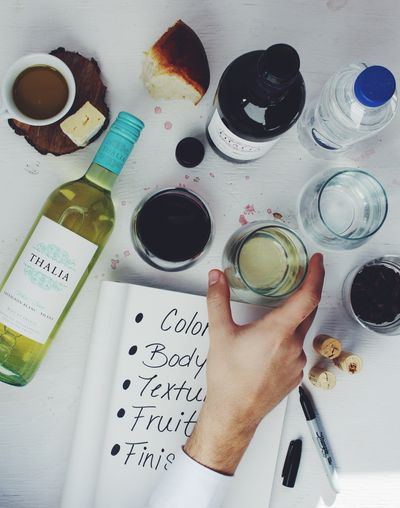Water Cooler: A beginner’s guide to tasting wine

Wine tasting has a reputation for involving a lot of snobbery when it’s actually very simple and fun. Taking the time to taste each wine you try can help you quickly develop your palate and inform your opinion on which wines you like and dislike.
Before drinking the wine, take a close look at it. First evaluate its hue and intensity. Wine color goes far beyond just red, white and rosé. The grape variety used in the wine will influence its color the most, but other factors are at play as well.
An aged or oxidized wine will develop more brown hues over time. Red wines with high amounts of sulfites or fermented at high temperatures tend to have diminished color intensity. Hue can also be an indication of the wine’s pH level. Strong red tends to indicate a low pH, or high acidity, whereas wines with a blue or magenta hue indicate a slightly lower acidity.
Observe the wine’s color range by viewing the wine straight down the glass, then hold it up to a light to look straight up the glass. Next look at it through the side while holding it in the light to see how murky or clear it is. Tilt the glass so it thins out and shows clues about its weight and age. Find a wine color chart for a handy reference and to get a better idea of the variety of colors in wines.
Next, swirl the wine so you can observe its “tears” or “legs.” Technically, this is an observation of the Biggs-Marangoni effect, but it is sometimes even referred to as the wine’s fingers, curtains, church windows or feet.
After the wine is swirled, capillary action causes liquid to climb the side of the glass and leaves behind a clear ring of liquid. The alcohol and water evaporate. Alcohol’s fast evaporation increases the surface tension of the remaining liquid, allowing more liquid to cling to the side of the glass. Droplets form and fall down the sides of the glass under their own weight, forming legs or tears.
Higher alcohol content creates more of these droplets. When people say a wine has “good legs,” it has more to do with the alcohol content than it does the quality of the wine. Sometimes the legs can be confused with wines that are a bit sticky due to their high sugar content.
Swirl the wine, then stick your nose near the rim of the glass and quickly inhale. Wines have hundreds of aromas, and interpreting them is up to you. There is no wrong answer. Maybe you smell apple. Is it fresh, or does it smell ripened or dried? Try to pick up two other aromas.
Other aromas include herb, savory or even mineral notes, such as espresso, balsamic, rosemary or petroleum. Wine can also have robust aromas like allspice, chocolate, vanilla or tobacco, which develop from oak aging. There are also earthy aromas, thought to be determined by where and how the grapes are grown. This includes things like mushroom, loam, rich soil or rocks.
Swirl once more and take a sip. Swish before swallowing to observe how the wine feels in your mouth and what flavors it imparts. High amounts of tannin cause a puckering, grainy effect. Sweet wines may feel syrupy. A tart wine will cause your mouth to water.
After swallowing, inhale through your mouth and exhale through your nose to pick up new aromas you didn’t detect at first.
Now you’ve tasted the wine. Ask yourself what you thought. Was it balanced, simple, complex, enjoyable? Use these reflections to form your opinion of the wine, and you’ll be on your way to discovering your favorites.